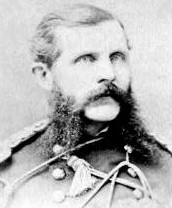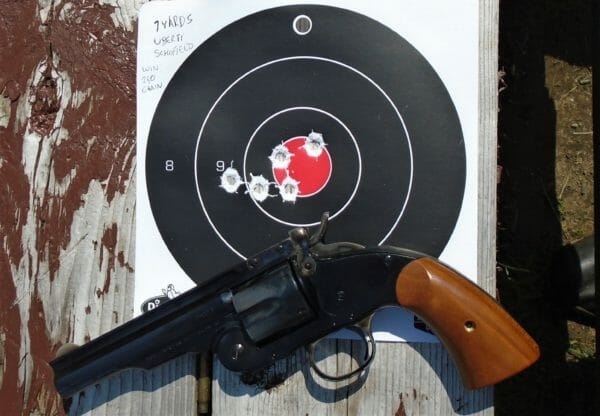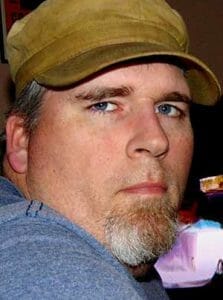David gives us some history on the Uberti Schofield Wells Fargo Revolver as well as a range report.

USA – -(AmmoLand.com)- To many who are uninitiated or born in the last few decades, they may think that there was only one revolver that was present during the heyday of the Old West, the Colt Single Action Army. They might not have known that there was a major competitor for Colt’s supremacy, not only in the hands of the everyday cowboy, outlaw, and lawman but also the United States Army, and that was the Smith & Wesson Model 3, Schofield.
The Schofield revolver was the brainchild of Colonel George W. Schofield, but to appreciate his contributions, you have to understand what he had to work with from the very beginning.

Smith & Wesson found themselves as major players in the revolver market with their small tip-up revolvers like the Model 1 starting in 1857. While not a powerful gun being only in .22 Short, the bored through cylinder was revolutionary, and while Smith & Wesson was improving on their design and patent, Colt was still forced to use their percussion revolvers as they were, still working on existing technology. All while waiting for Rollin White’s patent to expire so they could get in on the action.
After fifteen years Smith & Wesson had improved and enlarged their revolvers until they had come up with the Model 3. The Model 3 was a large frame gun, and in a much larger caliber which was the problem that most had with many of the earlier Smith & Wesson revolvers. In 1870 the US Army adopted the Model 3 in .44 American.
The Russian military was the most significant buyer of the Model 3, with their version with perhaps the strangest grip and a spur on the trigger guard. The Russian version also was in its unique caliber, the .44 Russian, which was the grandfather of the .44 Magnum. The Russian military ordered 131,000 of the Model 3 revolvers, a financial arrangement that saved the company and put Smith & Wesson on solid ground.

The Russian revolver, like the Model 3 that the US Army adopted had one thing in common; they had the latch to break it open on the barrel, which is where Colonel George Schofield came in. Schofield observed that while the Model 3 was more natural to load and unload by breaking the revolver open, it required the use of two hands to do so. Schofield redesigned the latch and put it on the frame itself. This allowed the shooter to operate the latch with one hand, and then break the gun open even on horseback by pushing against his leg and dumping the spent casings. Schofield started working on the refinements in 1871, and as talks progressed, the Army also wanted the new version to be in .45 Colt, but the length of the cylinder was too short, the rim of the extractor didn’t grab it as well, and the cost would have been too prohibitive. A compromise was reached when Smith & Wesson said they could make a .45 caliber round that would work in both the Model 3 and the Colt SAA, the Army accepted and in 1875 they placed an order for three thousand of the new revolvers, which became known as Smith & Wesson Model 3, Schofield.

The Schofield lost the exaggerated hump on the grip frame of the Russian version, going back to the rounded design of the .44 American. It had a blued finish and a 7-inch barrel which gave the gun a nice balance, but for those used to the Colt SAA, the grip angle is totally different. By the end of 1877, the US Army had ordered eight thousand Schofield revolvers.
Not all of the Schofield revolvers served out west; the New York militia received two thousand and Michigan five hundred and thirty-six. Other states as far east as Maine and Florida were issued Schofields in very small numbers, while no more than a handful.
The first drawback and its biggest was the round. The .45 Schofield, of course, worked in the Model 3 Schofield but the .45 Colt round was too long to fit the Smith & Wesson’s cylinder. While we can just run out and get a box of correct ammunition for a gun these days quickly, out on a frontier, hundreds of miles from any reinforcements meant with incorrect ammunition in those days could be disastrous, especially since the .45 Schofield rounds would work in the Colt SAA revolver. The US Army finally came up with a solution with a compromise round, the 1887 Military Ball Cartridge. This round had the length to fit the Schofield and the reduced rim of the .45 Colt to help with extraction. The problem is that this was twelve years after the Army adopted the Schofield, by then the damage had been done, the numbers of Colt SAA revolvers outnumbered the Smith & Wesson by then, and there was no sense requesting guns that the ammunition when it arrived might not work in.
The other issue that the Schofield had which has been speculated to leading to the end of the purchasing of the revolver was another member of the family, John M. Schofield, the head of the US Army Ordnance Board, who was essentially in charge of deciding which guns to buy. This was a sticky situation being that his brother George was getting a small payment for every revolver that sold thanks to his design. It’s never been fully proven, but it was a shocking conflict of interest that would have been a major political scandal had it been true.

No matter what caused the end of the Schofield in the hands of the US Army, the revolver didn’t disappear. It was well-liked by many, and still in use by some units until 1898. Surplus guns were purchased by dealers like Bannerman and Schuyler, Hartley & Graham. The barrels were often cut down to 5-inches and refinished in nickel. Wells Fargo purchased many of these guns to arm their messengers, and they’re marked over by the company and given a new serial number.
The Schofields continued to be popular throughout the west. But despite that fact Smith & Wesson had given up on it and quit making the revolver in 1877 along with all the other Model 3’s. They made this move at the time in favor of the New Model which went back to older style latch of the American & the Russian and a new grip frame with a slightly raised hump that was more pleasant to hold than the Russian.
As for George Schofield, he eventually advanced to the rank of Lieutenant-Colonel, but he took a downward turn and on December 17, 1882, while battling mental illness and isolation. He took his own life with a revolver he helped design. One can only wonder had Schofield lived if he could he have advanced firearms technology along with more or created more guns.
I have always had a fascination with the Schofield revolver, my first time seeing one, like many, was in the Clint Eastwood film Unforgiven.
The western masterpiece showcased a variety of firearms not often seen in films, like a Starr revolver & a Spencer carbine, guns at that time ignored for the most part on screen. The star though next to Clint Eastwood though was the Schofield revolver, which saw a lot of screen time and got many people interested in acquiring one.
Uberti Schofield Wells Fargo Revolver
When I got older, I found out that the original Schofields were not very affordable, something that really hasn’t changed. What we do have however thankfully are the wonderfully made replicas by Uberti, who have not only faithfully reproduced the gun in its original form as issued to the US Army but also the Wells Fargo 5-inch model and a hold-out version with a 3 ½ -inch barrel. You can get them in .38 Special, .44-40 and .45 Colt.
Between 2000 and 2003 Smith & Wesson made a limited run of Schofield revolvers, but they had some modern improvements, including a transfer bar that allowed you to load all six rounds safely and like the originals, they were chambered in .45 Schofield.
I finally acquired after many years of mulling it over, a Uberti Schofield revolver. I decided on the 5-inch Wells Fargo version because it would be easier to carry it around should I decide to take it on a hike or trail sometime. The quality of this revolver is exceptional, as one would expect from Uberti, and it isn’t a cheap gun to own. You can get lost in the bluing though, and the case coloring on the latch is top-notch. One thing I did do was to replace the grips. I had heard before and felt that the original grips were very blocky, so I found a set of unfinished grips made from cherry. I put four coats of Tru-oil on them, and they look fantastic, but also because they’re slightly thinner they let me reach the thumb with my hand to cock the hammer back easier.
When I took the Schofield to the range, I found out why so many favor the gun. To open the revolver, you have to put it on half cock, then pull back the latch, and the gun opens to load. Since my gun is in .45 Colt, if I wanted to get or load .45 Schofield rounds, that wouldn’t be an issue, but the bigger round is right at home in this gun.
I set up a bullseye target at 7 yards and shooting offhand, one-handed, the Schofield with Winchester 250 grain lead ammo is simply a joy to shoot. Many say they find the Schofield uncomfortable to shoot compared to the Colt SAA, but I think the best way to describe it as it’s different. I think if you have shot nothing but the Colt, then yes, you might not like it. I’ve shot the Colt SAA, Ruger Vaquero and Blackhawks for going on twenty-five years and I can tell you I could easily get used to the Schofield with practice.

I then put out one of my silhouette targets at 10 yards and repeated the same thing, offhand one-handed, and the Schofield responded. The trigger on this gun breaks very cleanly and is very smooth. A Wells Fargo Road Agent armed with such a gun back in the late 1800s was certainly a force to be reckoned with.

Ejecting the empty shells was simple and quick, I even tried the cavalry method of opening the gun one-handed and brushing the Schofield against my leg and dumping the empties. It works perfectly as long as you remember to turn and dump the gun to shake loose any brass that might be a little sticky.

It is no wonder why the Schofield holds such a place in firearms history. The Model 3 Smith & Wesson was a good design, and George Schofield improved on it. He played a role in making a gun better by way of experience in the field, and both the Army and Smith & Wesson paid attention.
The Uberti Model 3 Schofield is a wonderful revolver and would make a great addition to anyone’s collection, whether you’re a Cowboy Action Shooter or just a fan of Western firearms. If you do get one, you won’t be disappointed and you’ll need a putty scraper to take the grin off your face after shooting it.
About David LaPell
David LaPell has been a Corrections Officer with the local Sheriff’s Department for thirteen years. A collector of antique and vintage firearms for over twenty years and an avid hunter. David has been writing articles about firearms, hunting, and western history for ten years. In addition to having a passion for vintage guns, he is also a fan of old trucks and has written articles on those as well.
